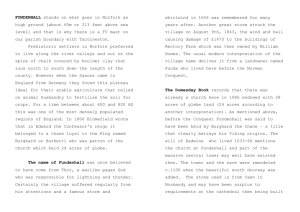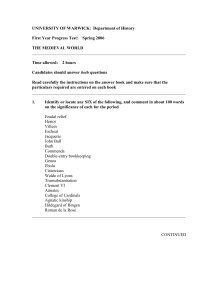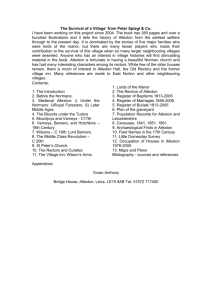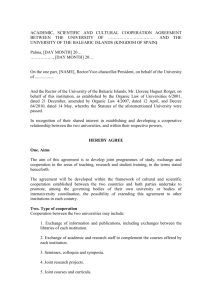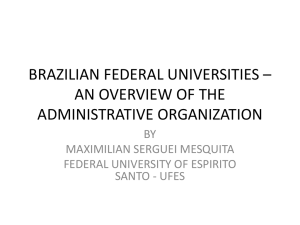Academic Leadership in Transition - Academic or Managerial? AC21 International Forum, Warwick
advertisement
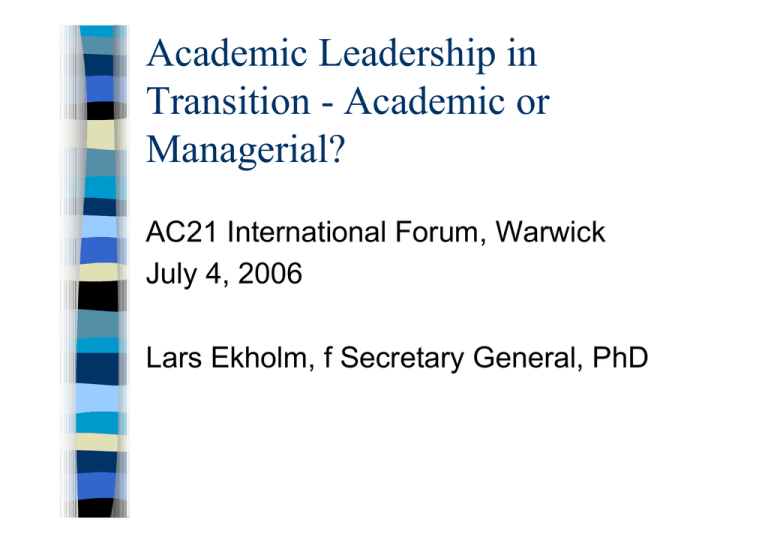
Academic Leadership in Transition - Academic or Managerial? AC21 International Forum, Warwick July 4, 2006 Lars Ekholm, f Secretary General, PhD Outline Part I Facts Swedish higher education - some facts Academic leadership - Then and Now Appointing/electing a rector Leadership support structure Career and gender pattern Training programs IDAS - women´s network Outline (cont´d) Part II What do the rectors think themselves? Part III Discussion The situation today 7 discussion points My ideal rector Swedish Higher Education Some Facts 9 million inhabitants 38 HE institutions - 15 universities - 22 university colleges, with and without PhD awarding rights - 7 university colleges of art They are state agencies (!) Swedish Higher Education Some Facts (cont´d) Participation rate: target 50 % of an age cohort R&D: 4 % of GDP (public and industry) State funding of research: 1 % Very few independent research institutes, therefore high % for external funding at universities Swedish Higher Education Some Facts (cont´d) Ministry of Education, National agency for HE (for QA mainly), Rectors´ Conference, 38 institutions Development over the last three decades: From a centralised national system to a fairly decentralised one Academic Leadership - Then and Now THEN Rector as primus inter pares Board: Full professors, with rector in the chair Full academic control - but with a narrow scope for decision in a centralised system Academic Leadership - Then and Now (cont´d) GRADUAL DEVELOPMENT More and more decision-power was handed over the universities/university colleges Discussion started about academic leadership Board: Students and external people are included, first on a trial basis (students) and in a minority (external), then as full members and in a majority Academic Leadership - Then and Now (cont´d) NOW Full discussion on academic leadership Training programs Rector´s mandate period: 6 + 3 years Board: 15 members, of which 8 (majority) are lay members, 1 rector, 3 students, 3 elected academic staff The rector represents the institution. The board oversees all matters, but not the academic ones Appointing/Electing a Rector The board sets up a search committee The board is obliged to get the advice of academic staff, other staff and students - this is practised in different ways The board takes a decision, hands over to the Government The Ministry decides on the salary, the Government appoints Concrete example: University College of Dance Leadership Support Structure Rector Pro-Rector (Deputy) (elected) More Pro-Rectors or Vice-Rector (appointed) Registrar/Director A management team - or a means to balance opposing (academic) factions? Career and Gender Pattern Universities: In most cases the candidate is chosen from within her or his own university University colleges: Chosen from other institutions (for natural reasons); this might change Only a few of them move around Career and Gender Pattern (cont´d) Most , but not all, have solid academic background. Many have been deans, some have a little external experience. Just a few have been recruited from outside academia At the moment: Almost 40 % are women Training Programs For newly appointed rectors: Official introductory program by the National Agency - both “facts” and group interaction “Academic Leadership Program” for potential leaders (pro-rectors, deans etc) “Retreats” by the Rectors´ Conference every second year - for the “soul” Training Programs (cont´d) Many institutions run their own leadership programs (example: Luleå Technical University) Programs for tomorrow´s leaders, by institutions and by external financiers IDAS, a program for promoting female academic leadership IDAS Identification, Development, Advancement, Support Goal: More women in high level positions at Swedish universities and university colleges Initiated by the Swedish Rectors´ Conference IDAS (cont´d) The network consists of about 70 women, successful in the academic world Central activities, in combination with local activities. Participants in the network are driving forces. New participants are identified at each institution IDAS (cont´d) Rectors : Gender balance 1999 F M Universities 3 11 Un colleges 0 17 Un coll of art 2 5 2006 F M 5 9 7 11 3 4 What Do Rectors Think about their Mission? 20 rectors have been interviewed, in personal terms Questions: What do you want to achieve? What support have you had in your leadership? What personal qualities are necessary for a rector? What qualities have been your own best asset? How did you become a leader? What has surprised you most? Advice to a new rector? What Do Rectors Think about their Mission - Some Results What support have you had? - The management team - Other rectors, through training programs Someone outside the university Chairman of the board Former rector Wife What Do Rectors Think about their Mission? (cont´d) What has surprised you most? - You have power - You are exposed, no support from the employer; alone with tough decisions - Media are tough - Everything you say is analysed - Hard work, 11 hour per day - Enormous variety of issues, expectations are high - You meet a lot of kindness What Do Rectors Think about their Mission? (cont´d) - I was interviewed about artistic and pedagogical aspects, but the work was most about budget, human resources etc - Conservatism of the academic world - Difficult to carry out reforms - you have the arguments but meet the mountain - It´s easier to manage an organisation based on technology What Do Rectors Think about their Mission? (cont´d) Road to rectorship? - I had not thought about this until they asked me - I´m interested in changing things, and changes presupposes power - Aristotle: The importance of practical knowledge - I attended a leadership course at Volvo - Step by step within academia, dean the latest one - I like leadership, but I have had no systematic plan - I have worked with good leaders What Do Rectors Think about their Mission? (cont´d) - I think I´m good at planning and organising, this gave the start - It´s OK to accept a job because you are a woman - Among academics leadership is suspicious, you have to make it on your own - Started on the PhD student board, and it has gone on; the importance of mentors To Sum Up A tradition of a rather “weak” rector, but it has definitely developed in the direction of management. Still there is a tension - is a new managerial style compatible with a true academic orientation? Is the Board a competing power? No it´s there mainly to support the rector. To Sum Up (cont´d) Highly increased expectations from society: More management, give the rector the instruments for it Government expectations: Improved gender balance (also demands from within) No systematic career planning, but a number of training opportunities Are the rectors prepared when asked? To Discuss How do we spot possible managers at an early stage? Should one do this? What do we do with them? Is the choice of rectors too traditional? Only academics, a few with additional merits. Big universities: Mostly from within. The balance between academic merits, giving legitimacy, and prior management and administrate merits To Discuss (cont´d) More women - seems under way, but is the situation stable enough? How can a rector improve in her/his job? Is it only for natural talents - or can one learn to become a competent manager? Training programs, and of what kind? The importance of selfreflection! To Discuss (cont´d) The proper basis for exercising power. The mandate period? Salary and other symbols of power (cars or bicycles)? Composition of the top management team THE HEART OF THE MATTER: How to balance a managerial style with collegiality? To Discuss (cont´d) The career after the mandate period too poor!

